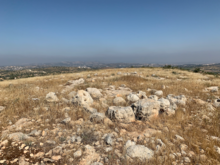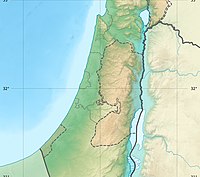The so-calledBull Siteis a 12th-century BCE open air ancientcultinstallation[1]found atDhahrat et-Tawileh[2](also spelled Daharat et-Tawileh),[3]in theWest Bank.The site is named for the bronzesacred bullstatuette which was found at the site in 1977.
 The Bull Site on the Dhahrat et-Tawileh ridge | |
| Location | Dhahrat et-Tawileh |
|---|---|
| Region | West Bank |
| Coordinates | 32°24′33″N35°19′25″E/ 32.409152°N 35.323578°E |
| Altitude | 455 m (1,493 ft) |
| Type | Cult installation |
| Length | 23 metres |
| Width | 21 metres |
| Area | 380 sqr metres |
| History | |
| Material | Stone, bedrock |
| Founded | 12th century BCE |
| Abandoned | 12th century BCE |
| Periods | Iron IA |
| Cultures | Canaanite, Israelite, or migratory population |
| Site notes | |
| Discovered | 1977 |
| Excavation dates | Apr 1978, Sept 1981 |
| Archaeologists | Amihai Mazar |
| Condition | In ruins |
Location
editThe site is located on the Dhahrat et-Tawileh ridge in the hills of the northern West Bank[4]inJenin Governorate,75 meters above theancient road[5][6]through theZababdehvalley[7]betweenDothanandTirzah.[8]It lies approximately 6 km south ofJenin,and 4 km east ofQabatiya.The site provides commanding views of other high points in northern Canaan includingMount Carmelto the west,Mount TaborandMount Meronto the north,Mount Gilboato the northeast, and to the south Jebel Tamun[9](also spelled Jabal Tammun, 'Mount Tammun', some 2 km SSE of the town ofTammun,altitude 588 m, prominence 291 m[10]).
Discovery
editThe site was discovered in 1977 by Ofer Broshi, a member ofKibbutz Shamirand soldier in theIsraeli army,where he unearthed anancient bull statuette.He brought the figurine back to his kibbutz where it was put on display with other antiquities owned by the kibbutz.[11][12]While on display it was spotted by archaeologistAmihai Mazarwho arranged its transfer to theIsrael Museumwhere it is now part of the permanent collection.[13]Based on Broshi's description Mazar was able to locate the discovery site at Dhahrat et-Tawileh and beginexcavations.[14]
Excavation history
editTwo short excavations were conducted by Mazar in April 1978 and September 1981 on behalf of the Institute of Archaeology at theHebrew University of Jerusalem.[15]Results of the excavation show that the site was single-phase (Iron IA)[16][17]and was abandoned after only a short period of use.[9][18]The archaeological evidence indicates the site's use as a cultic installation[19]though theflintandpotteryassemblage discovered potentially indicates domestic use.[20]Israel Finkelstein's dating of the site to theMiddle Bronze Age[21]is, according to Mazar, based on a misreading of the pottery evidence[22]and as such an early 12th-century dating should be retained.[23]
Cult installation
editThough there are a number of Iron Age I settlements in the area,[24]the Bull Site lacks any evidence of settlement. Instead it sits on the summit of Dhahrat et-Tawileh and is thought to have served as a cult site for the surrounding settlements due to its hilltop location.[9][25]
Built onbedrockin the 12th century, the site comprises a perimeter wall made from large boulders brought in from elsewhere,[26]and what is thought to be a standing stone oraltarwith a paved area in front of it next to the enclosure's eastern entrance.[27]Mazar, the excavation director, speculates that asacred treelikely grew within the site's walls.[28][29]
There is no agreement on theethnicityof the local settlers who used the site, with suggestions ranging from theIsraelitesdue to the site's location inMannaseh'stribal allotment (Joshua 17:1–13),[1][30][31]the Canaanites,[32]or migrants from north of Canaan.[33]
Alternative views are that the site could have been a home for a family and their animals, or anenclosureforlivestock.[32]
Calf statuette
editThe statuette, found close to the western wall of the site,[34]is of aZebubull measuring 17.5 cm long by 12.4 cm high and is made ofbronze.[35]It is notable not only for its naturalistic ears and eyes,[35]but for being the largest such bull statuette found inPalestine.[34]Though Mazar suggests it may be the product of a local Israelite craftsman,[25]other scholars such as Ahlström believe it came either fromGalilee,or further north again above the land of Canaan.[33]
There is no consensus about which deity the statuette represents;[36]it could be an image ofBaal[37]orYahweh.[38][39]
See also
editReferences
edit- ^abBloch-Smith & Alpert Nakhai (1999), p. 76.
- ^Ahlström (1990)
- ^Mazar (1982)
- ^Mazar (1982), pp. 32-33.
- ^Dorsey (1991), pp. 144-145.
- ^Miller II (2003), p. 161.
- ^Zertal (2008), p. 29.
- ^Alpert Nakhai (2001), p. 170.
- ^abcMazar (1982), p. 33.
- ^Jabal Tammunon peakvisor
- ^Mazar (1982), p. 41.
- ^Mazar (1983), p. 34.
- ^"Israel Museum Collection - Bull Statuette".imj.org.il.
- ^Mazar (1983), pp. 34-35.
- ^Mazar (1993), pp. 266-267.
- ^Mullins (2012), pp. 590-592.
- ^Faust (2006), p. 119.
- ^Ahlström (1990), pp. 80-81.
- ^Mazar (1983), pp. 35-36.
- ^Miller II (2005), p. 46.
- ^Finkelstein (1998), pp. 94-98.
- ^Na'aman (1994), pp. 167-169.
- ^Mazar (1999), pp. 144-148.
- ^Khirbet Abu Ghamam, Khirbet Tanin, Khirbet Anahum, Khirbet esh-Sheik Seffrin, and esh-Zababde. See Mazar (1983), p. 36.
- ^abMazar (1983), p. 39.
- ^Zevit (2003), p. 233.
- ^Mazar (1982), p. 34.
- ^Mazar (1982), p. 35.
- ^Mazar (1983), p. 37.
- ^Mazar (1982), p. 38.
- ^Alpert Nakhai (1994), pp. 19-29.
- ^abCoogan (1987), p. 1.
- ^abAhlström (1990), p. 81.
- ^abAhlström (1990), p. 79.
- ^abMazar (1982), p. 27.
- ^Ahlström (1990), p. 80.
- ^Miller (2000), p. 32.
- ^Smith (2002), pp. 83-84.
- ^Bloch-Smith & Alpert Nakhai (1999), pp. 76-77.
Bibliography
edit- Ahlström, Gösta W. (November 1990). "The Bull Figurine from Dhahrat et-Tawileh".Bulletin of the American Schools of Oriental Research.280(280): 77–82.doi:10.2307/1357311.JSTOR1357311.S2CID163751741.
- Alpert Nakhai, Beth (2001).Archaeology and the Religions of Canaan and Israel.Boston, MA: American Schools of Oriental Research.ISBN978-0897570572.
- Bloch-Smith, Elizabeth; Alpert Nakhai, Beth (1999). "A Landscape Comes to Life".Near Eastern Archaeology.62(2).doi:10.2307/3210703.JSTOR3210703.S2CID163482783.
- Coogan, Michael David(1987). "Of Cults and Cultures: Reflections on the Interpretation of Archaeological Evidence".Palestine Exploration Quarterly.119(1): 1–8.doi:10.1179/peq.1987.119.1.1.
- Dorsey, David A. (1991).The Roads and Highways of Ancient Israel.The ASOR Library of Biblical and Near Eastern Archaeology. Wipf and Stock.ISBN978-1-5326-6089-4.
- Faust, Avraham(2006).Israel's Ethnogenesis: Settlement, Interaction, Expansion and Resistance.London and New York: Routledge.ISBN9781845534561.
- Finkelstein, Israel(1998). "Two notes on Northern Samaria: the 'Einun Pottery' and the date of the 'Bull Site'".Palestine Exploration Quarterly.130(2): 94–98.doi:10.1179/peq.1998.130.2.94.
- Mazar, Amihai (Summer 1982). "The" Bull Site ": An Iron Age I Open Cult Place".Bulletin of the American Schools of Oriental Research(247): 27–42.doi:10.2307/1356477.JSTOR1356477.S2CID164091738.
- Mazar, Amihai (September–October 1983)."Bronze Bull Found in Israelite" High Place "from the Time of the Judges".Biblical Archaeology Review.9(5).
- Mazar, Amihai(1993). "'Bull' Site ". InStern, Ephraim(ed.).The New Encyclopedia of Archaeological Excavations in the Holy Land.Vol. 1. Carta.ISBN0-13-276296-X.
- Mazar (1999). "The 'Bull Site' and the 'Einun Pottery' Reconsidered".Palestine Exploration Quarterly.131(2): 144–148.doi:10.1179/peq.1999.131.2.144.
- Miller, Patrick D.(2000).Israelite Religion and Biblical Theology: Collected Essays.Journal for the study of the Old Testament Supplement Series. Vol. 267.Sheffield Academic Press.ISBN9781841271422.
- Miller II, Robert (2003). "Gazetteer of Iron I Sites in the North-Central Highlands". InLapp, Nancy(ed.).Preliminary Excavation Reports and other Archaeological Excavations, Tell Qarqur; Iron I Sites in the North-Central Highlands of Palestine.The Annual of The American Schools of Oriental Research. Vol. 56. Boston, MA: American Schools of Oriental Research.ISBN0-89757-026-X.
- Miller II, Robert D. (2005).Chieftains of the Highland Clans: A History of Israel in the Twelfth and Eleventh Centuries B.C.Grand Rapids, MI; Cambridge, U.K.:William B. Eerdmans Publishing Company.ISBN978-0802809889.
- Mullins, Robert (2012). "The Bull Site".Encyclopedia of the Bible and Its Reception.Vol. 4. De Gruyter.ISBN978-3110183559.
- Na'aman, Nadav (1994). "The 'Conquest of Canaan' in the Book of Joshua and in History". In Finkestein, Israel; Na'aman, Nadav (eds.).From Nomadism to Monarchy.Israel Exploration Society.ISBN965-217-117-4.
- Alpert Nakhai, Beth (1994)."What's a Bamah? How Sacred Space Functioned in Ancient Israel".Biblical Archaeology Review.20(3).
- Parker, Simon B. (1997).Ugaritic Narrative Poetry.SBLWritings from the Ancient World. Vol. 9. Atlanta, GA: Scholars Press.ISBN978-0788503375.
- Smith, Mark S.(2002).The Early History of God: Yahweh and the Other Deities in Ancient Israel.Grand Rapids, MI; Cambridge, U.K.; Dearborn, MI: William B. Eerdmans Publishing Company.ISBN9781845534561.
- Zertal, Adam(2008).The Manasseh Hill Country Survey, Volume II, The Eastern Valleys and the Fringes of the Desert.Leiden; Boston:Brill.ISBN978-9004163690.
- Zevit, Ziony(2003). "False Dichotomies in Descriptions of Israelite Religion: A Problem, Its Origin, and a Proposed Solution". InDever, William;Gitin, Seymour(eds.).Symbiosis, Symbolism, and the Power of the Past: Canaan, Ancient Israel, and Their Neighbors from the Late Bronze Age through Roman Palaestina.Eisenbrauns Book Publishers.ISBN978-1575060811.
